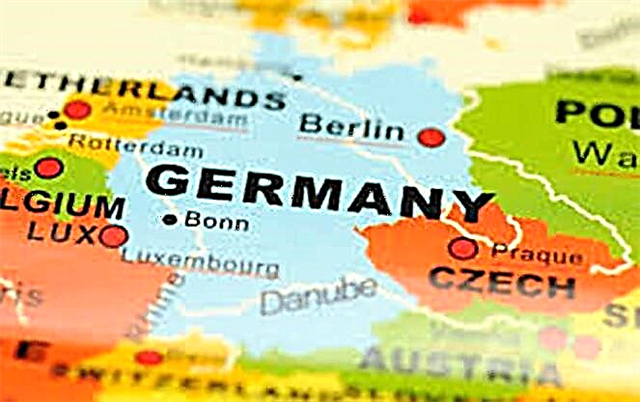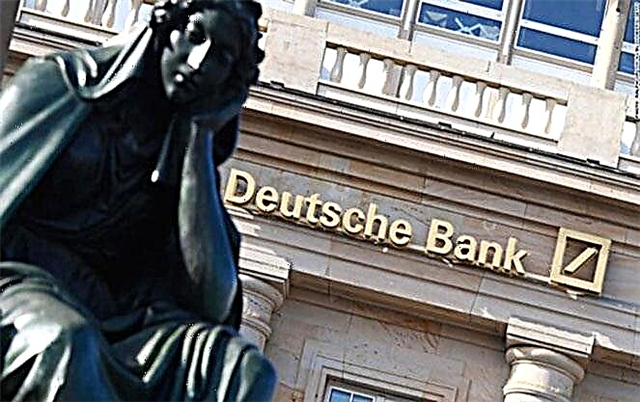Germany is the leader among EU countries in many respects, including living standards and GDP per capita. This country has a strong position in many sectors, including social, medical, educational, and financial. The banking system of Germany today is considered one of the strongest and most stable in the world. The level of overdue loans in this country does not exceed the two percent threshold - less only in the United States and Japan.

The specifics of the banking system in Germany
The main currency in Germany is the euro. It was Germany that became one of the initiators of the creation of the EU and contributed to the introduction of a common currency for all countries of the Eurozone. Germany is the leader in economic growth in Europe, which is largely facilitated by the country's strong banking system.
As of the end of 2021, there were 36,005 banks (branches and branches) in Germany, of which:
- 9 986 - commercial;
- 11 872 - savings banks, which are here called sparkassen;
- 11 847 - credit cooperatives (kreditgenossenschaften);
- 1557 - building societies or cash offices (bausparkassen);
- 411 - land (landesbanken);
- 65 - mortgage (realkredit-institute);
- 43 - with special tasks (banken mit sonderaufgaben);
- 13 - large cooperative central banks (genossenschaftliche Zentralbanken);
- 211 - the rest.
The features of the German banking system are as follows:
- the banking sector in Germany is divided into three parts: private, public, cooperative;
- the presence of the main state bank, the role of which is played by the German Federal Bank or the Bundesbank, as well as several state banks with special functions, mainly savings and credit;
- state-owned banks play a large role in the country's banking sector;
- strict regulatory regulation of the activities of credit and other financial institutions;
- the strictest reporting requirements, restriction of the rights of company owners;
- the presence of a single supervisory body over all types of financial services - BaFin;
- unification of second-tier banks into unions and associations (for example, the Union of Savings Banks and Fat Centers Deutscher Sparkassen-und Giroverband e.V.)
What is the structure of the banking system in Germany
The banking system of Germany, like many other developed countries, is characterized by a two-tier structure. At the top level is the Bundesbank - the central bank of Germany, whose main task is to implement the state's monetary policy, control its financial system, and implement monetary policy.

However, after the euro appeared in the Eurozone in 1999, and the German banking system joined the EU financial system, the European Central Bank began to exert a great influence on the country's financial institutions.
The lower levels of the German banking system are represented by savings banks, private and cooperative banks and other financial institutions.
Private banks
Private banks represent the largest segment of the German financial sector. They make up about 40% of all German financial institutions. Private are not only small regional financial institutions such as Bankhaus Lampe (Frankfurt) or Berenberg Bank (Hamburg), but also large centralized banks:
- Deutsche Bank (Deutsche Bank);
- Commerzbank (Commerzbank);
- Targobank (Targobank);
- Postbank (Postbank).
These banks play an important role in the country's economy. They are well known far beyond the borders of Germany, as their branches are located in many countries of the world, occupying far from the last place in the financial market of these countries.

In addition, the private sector includes banks that issue mortgages, construction cash registers, banks with special functions or tasks, as well as branches of foreign financial institutions (for example, Barclays Bank (Hamburg)).
State banks
In addition to private banks, there are quite a few public financial institutions in Germany. These include:
- savings banks;
- land banks.
The most massive category of state-owned banks in Germany is savings banks. They provide their services only within the region in which they are located.
Savings banks are created on the basis of municipalities, federal states and districts. Their main task is to support local businesses.
They offer entrepreneurs concessional financing, attracting low interest rates, since making a profit fades into the background for them. An example of such a financial institution is Sberbank in Munich (Sparkasse München Hauptfiliale). It is one of the five largest savings banks, has 89 divisions and employs about 2,350 people.
The central bank company at the regional level is made up of banks of the federal states. There are only seven of them:
- BayernLB;
- Norddeutsche Landesbank (Nord / LB);
- HSH Nordbank;
- Landesbank Baden-Württemberg (LBBW);
- Landesbank Berlin (LBB);
- Landesbank Hessen-Thuringen-Girozentrale (Helaba);
Their main task is to serve key clients for the state. They are also the central banks for regional savings banks.
Land banks build their activities by raising capital in order to provide loans to businesses. In addition, banks such as WestLB and BayernLB play an important role in the securities market and are engaged in attracting large international loans.
A prime example of a financial institution with specialized tasks is the KFW bank. This is a large state bank, whose main tasks are to develop various sectors of the economy, improve the social climate, and support small and medium-sized businesses. The structure of the KFW bank includes such specialized banks as:
- KfW Förderbank - specializes in lending to energy efficient projects in the field of residential construction and environmental protection;
- KfW Kommunalbank - invests in municipal infrastructure, public transport, as well as education: provides students with loans for studies;
- KfW Mittelstandsbank - is engaged in financing small and medium-sized businesses;
- KfW IPEX-Bank is the largest division of the banking group. It works in the financing market for German and European exports, finances large projects such as the construction of bridges, ports, tunnels, railways, etc.
- KfW DEG (Deutsche Investitions - und Entwicklungsgesellschaft mbH) is an investment corporation that deals with securities, provides loans to private companies, and also invests money in projects in developing countries.

Another specialized Agricultural Rent Bank, as the name suggests, provides support to agricultural enterprises in the country.
Cooperative banks
The first cooperative banks began to appear in Germany in the middle of the 19th century and initially served as mutual aid banks for traders and artisans. Today they exist in two forms:
- registered company;
- joint stock company.
Cooperative banks differ from other banking institutions in that their clients are also shareholders with voting rights. These banks form their capital by attracting free funds of depositors.
It should be noted that many cooperative banks successfully engage in capital trading on international markets.
The most famous cooperative banks are financial institutions such as Raiffeisenbank, Volksbanken, DZ-Bank. They are characterized by the presence of a large number of shareholders. These financial institutions have an extensive network of branches throughout the country, including even small villages. The sphere of influence of cooperative banks extends mainly to retail and corporate business.
Other types of banks
In addition to the above-mentioned financial institutions, there are also Internet banks in Germany. They provide all their services remotely via the Internet.These financial institutions are ComDirect, DKB Bank and N26.
Building societies or cash registers (bausparkassen) are created with the aim of accumulating the savings of clients who invest in housing assets through the provision of mortgage loans. The activity of the building offices is regulated by the special law Bankwesengesetz.
Mortgage banks (realkredit-institute) specialize in lending to the construction of large real estate objects, as well as large transport: passenger airliners and ships. Banks form the passive base by issuing debt obligations, which are secured by real estate or the state.

But there are no offshore banks in Germany, since the country has very strict legislation in relation to money laundering and it is necessary to confirm the sources of income. However, financial institutions such as Deutsche Bank and Commerzbank have been able to adapt by opening offices in offshore zones and are now able to provide related services.
The largest German banks
The largest banks in Germany are widely known: they are Deutsche Bank and Commerzbank. Both were created from large industrial groups for the purpose of serving them.
Deutsche Bank is the leading bank in Germany, it heads the country's largest financial and industrial group, which includes large enterprises - leaders in the energy and chemical sectors of the economy, as well as mechanical engineering. Its sphere of influence includes nuclear energy, electronics, mining and many other enterprises that are important for the state.
The financial institution has more than 13 million clients worldwide. Deutsche Bank has a network of about 1,500 branches throughout the country, with subsidiaries operating in 76 countries. The financial institution is headquartered in Frankfurt, the investment division is in London. Deutsche Bank's official website is www.deutsche-bank.de.
DZ Bank AG is the second largest commercial bank in Germany by assets. Its name literally translates as “German Central Cooperative Bank”. It is the headquarters for over 1,000 cooperative banks. Its main shareholders are Volksbanken and Raiffeisenbanken, which jointly own about 80% of the capital of DZ Bank AG.

This financial institution positions itself as a corporate and investment bank. Serves about 30 million clients. In 2021, DZ Bank AG merged with WGZ Bank, the central bank of the cooperative banks in the Rhineland and Westphalia. There are only 4 branches of DZ Bank AG in Germany: in Berlin, Munich, Hanover and Stuttgart. The headquarters of the financial institution is located in Frankfurt.
KfW is the third largest bank in Germany by assets. The share of the government in its capital is 80%, another 20% belongs to the federal states. The main source of funding for KfW is bonds guaranteed by the federal government. Thanks to this, the cost of resources for a financial institution is very low, which makes it possible to lend to a business on favorable terms. KfW also provides financing to companies and enterprises from other countries through its structures.
Commerzbank AG in Germany serves large industrial concerns and enterprises. In 2021, the financial group strengthened its position by taking over Dresden Bank. The latter specialized in servicing the Krupp industrial group: Metallgesellschaft-Degussa (leader in the production of precious metals + nuclear monopoly), AEG-Telefunken (the second largest electrical company), Grundig concern (radio engineering, electronics, military products).
The branch network of "Commerzbank" consists of 80 branches and representative offices in more than 50 countries, which serve about 8 million customers. Commerzbank provides a full range of financial services for both retail and corporate clients: deposits, loans, Internet banking, etc.
Unicredit Bank AG is the fifth largest bank in terms of assets and the fourth largest bank in Germany. The financial institution is better known under a different name - Hypovereinsbank (HVB). It changed its name in 2005 after it was bought out by the Italian bank UniCredit Bank AG. Unicredit Bank AG is a universal financial institution providing a full range of retail and corporate services.

List of the largest German banks as of 2021:
| Name | Assets, billion euros |
|---|---|
| Deutsche Bank AG | 1590,546 |
| DZ Bank AG | 509,447 |
| KfW | 507,013 |
| Commerzbank AG | 480,45 |
| Unicredit Bank AG | 302,09 |
| Landesbank Baden-Württemberg (LBBW) | 243,62 |
| Bayerische Landesbank (BayernLB) | 212,15 |
| Landesbank Hessen-Thüringen (Helaba) | 174,99 |
| Norddeutsche Landesbank Girozentrale (Nord / LB) | 174,797 |
| ING-Diba AG | 157,553 |
| Postbank AG | 147,197 |
| NRW.Bank | 142,066 |
| Landwirtschaftliche Rentenbank | 95,046 |
What German banks are in Russia and what Russian banks operate in Germany
In 2021, the following financial institutions with German roots operate in Russia:
- Deutsche Bank. The main and only office of the bank is located in Moscow. Serves large corporate clients. Mainly works in the securities market, provides depository services, and also conducts treasury operations.
- "Commerzbank (Eurasia)". It has two representative offices in Russia: the main office in Moscow and a branch in St. Petersburg. Specializes in servicing large corporate clients. Provides the following range of services: corporate financing, documentary and guarantee operations, settlement and cash services.
- Volkswagen Bank Rus is controlled by the automobile concern of the same name. The main activity of the bank is the provision of auto loans to legal entities and individuals for the purchase of Volkswagen cars, as well as other automakers that are part of the auto concern. The only office of the bank is located in Moscow.
- “BMW Bank” - like the previous bank, is controlled by the German auto concern of the same name. Specializes in providing loans for the purchase of BMW cars.
- Mercedes-Benz Bank Rus is controlled by Daimler AG. Specializes in obtaining car loans for individuals and legal entities for the purchase of cars, which are produced by the auto concern.
In turn, there are representative offices of Russian banks in Germany:
- Sberbank;
- Vnesheconombank;
- VTB.
All representative offices of Russian financial institutions are located in Frankfurt.
What you need to open a bank account
For residents of EU countries, the desire to open a current account will not be a problem, but the rest of the categories of clients need to have:
- residence;
- work permit.
As a rule, in order to open an account, the client must be present in person. However, some online banks - DKB Bank, Comdirect and N26 - provide services remotely. However, in order to open an account, a potential client must send notarized documents to the bank.
A checking account or GiroKonto can be used for settlements both domestically and abroad. To access the account, the client is issued a payment card.
To be able to use the account, you must submit to the financial institution a week before its opening:
- international passport;
- passport;
- registration sheet (Meldebescheinigung);
- TIN in the country of residence;
- proof of income. In this case, the banker may request to provide the last three paid invoices or an account statement;
- a letter from the employer indicating the level of salary and position.
Some banks, such as Sparda Bank in Nuremberg or Norisbank in Bonn, do not require income information when opening an account.
The cost of opening an account depends on the bank's tariffs. Some financial institutions offer GiroKonto for free.
How to prove your creditworthiness with SCHUFA
SCHUFA is Germany's leading credit bureau. It contains information on 66.4 million people and 5.2 million companies. Every client who applies for a loan immediately enters the SCHUFA database.Based on the information received about the borrower, the credit bureau calculates his solvency and assigns a certain number of points - from 1 to 100. Moreover, the lower the points, the lower the likelihood of loan approval.
Data on repaid loans, closed credit cards are stored in the SCHUFA database for three years. More about SHUFA.
Finally
The banking system in Germany is two-tier: the Bundesbank, which plays the role of the central financial institution of the country, is subordinate to all other banking structures. The second tier of the banking system is characterized by a variety of financial institutions. They are conventionally divided into three main groups: private, state and cooperative.
The German banking system is mainly represented by savings banks, credit cooperatives and private banks. Savings banks are subordinate to the regional land bank and are located in almost every settlement. There are also many small private banks in Germany, which often have an office in only one city, even in such a small one as Metlach.
The largest financial institutions in Germany are Deutsche Bank, German Central Cooperative Bank, Commerzbank. The Russian banking sector is represented in Germany by Sberbank, VTB and VEB.











